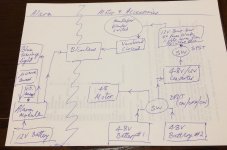Reflector
10 W
I want to share my turn signals between the batteries of;
1) an alarm system
2) my 12V velomobile supply (lights, horn, fan and turn signals)
When my (48) motor supply is turned off, there is no feed to the 48V / 12V buck converter which then feeds the supply (in #2 above).
To share the signals between both electrical systems, would I just need to install diodes at appropriate places or would e.g. using the SPST switch in the diagram do the trick to prevent possible accidental voltage feedback?
PS
turn signals = blinkers = indicators
1) an alarm system
2) my 12V velomobile supply (lights, horn, fan and turn signals)
When my (48) motor supply is turned off, there is no feed to the 48V / 12V buck converter which then feeds the supply (in #2 above).
To share the signals between both electrical systems, would I just need to install diodes at appropriate places or would e.g. using the SPST switch in the diagram do the trick to prevent possible accidental voltage feedback?
PS
turn signals = blinkers = indicators


